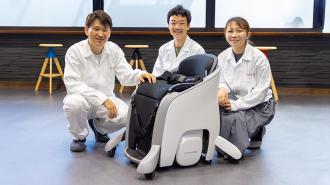Honda Robotics has unveiled a prototype of a hands-free wheelchair that you steer with your body weight, just like a Segway, making it easier for people with mobility issues to get around.
The challenge: Here’s an unfortunate, surprising fact: more than 12% of American adults have a disability that makes it seriously difficult for them to walk or climb stairs, and while mobility aids — such as walkers or wheelchairs — can make it easier to move around, they have their own limitations.
Because they are controlled by the hands, the person using the device might not be able to multitask like others would while walking — imagine moving through an amusement park with a group of friends, and while they’re all eating a snack, you’re stuck using your hands to propel your wheelchair or walker.
Most wheelchairs require you to remain in a seated position, too. This means you aren’t at eye level with those around you, which can make communication feel less natural.
A hands-free wheelchair: Honda Robotics has now unveiled the UNI-ONE, a cross between a wheelchair and a Segway, at the Japan Mobility Show 2023.
Once a person is seated and strapped in, they’re lifted to a semi-seated position that puts them at about eye level with anyone standing next to them. To steer the UNI-ONE, they just have to shift their body weight, leaving their hands free (though they can use a joystick to control the device from the lowered position, if they prefer).
The battery-powered UNI-ONE has a reported range of about 5 miles or two hours of use and a top speed just below 4 miles per hour. The device is still a prototype, though, so it’s possible that the specs for the production model could be different.
Honda told conference attendees that it aims to launch the hands-free wheelchair in 2025, starting with the US and Japanese markets. Rather than selling it, Honda plans to lease it for the equivalent of $800 per month in Japan (it hasn’t said whether the cost would be similar in the US).
The big picture: The UNI-ONE isn’t the first hands-free wheelchair we’ve seen — Segway unveiled a similar concept, the S-Pod, in 2020, and the “Walking Wheelchair” designed by London architect Suzanne Brewer also includes the option of being elevated to eye level.
While those were just prototypes, Arizona-based mobility company Omeo has a hand-free wheelchair that’s already available for purchase in the US for about $30,000.
That cost likely puts it out of reach for many people with mobility issues, but the leasing angle could make the UNI-ONE attractive to amusement parks, college campuses, and other places where people are expected to walk long distances.
It’s not hard to imagine those organizations leasing UNI-ONEs from Honda and offering them to visitors — ensuring everyone is able to fully enjoy their facilities.
We’d love to hear from you! If you have a comment about this article or if you have a tip for a future Freethink story, please email us at tips@freethink.com.
